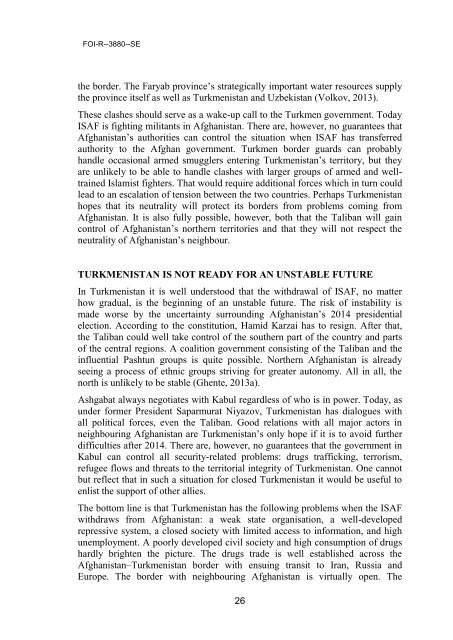foir_3880
foir_3880
foir_3880
Create successful ePaper yourself
Turn your PDF publications into a flip-book with our unique Google optimized e-Paper software.
FOI-R--<strong>3880</strong>--SE<br />
the border. The Faryab province’s strategically important water resources supply<br />
the province itself as well as Turkmenistan and Uzbekistan (Volkov, 2013).<br />
These clashes should serve as a wake-up call to the Turkmen government. Today<br />
ISAF is fighting militants in Afghanistan. There are, however, no guarantees that<br />
Afghanistan’s authorities can control the situation when ISAF has transferred<br />
authority to the Afghan government. Turkmen border guards can probably<br />
handle occasional armed smugglers entering Turkmenistan’s territory, but they<br />
are unlikely to be able to handle clashes with larger groups of armed and welltrained<br />
Islamist fighters. That would require additional forces which in turn could<br />
lead to an escalation of tension between the two countries. Perhaps Turkmenistan<br />
hopes that its neutrality will protect its borders from problems coming from<br />
Afghanistan. It is also fully possible, however, both that the Taliban will gain<br />
control of Afghanistan’s northern territories and that they will not respect the<br />
neutrality of Afghanistan’s neighbour.<br />
TURKMENISTAN IS NOT READY FOR AN UNSTABLE FUTURE<br />
In Turkmenistan it is well understood that the withdrawal of ISAF, no matter<br />
how gradual, is the beginning of an unstable future. The risk of instability is<br />
made worse by the uncertainty surrounding Afghanistan’s 2014 presidential<br />
election. According to the constitution, Hamid Karzai has to resign. After that,<br />
the Taliban could well take control of the southern part of the country and parts<br />
of the central regions. A coalition government consisting of the Taliban and the<br />
influential Pashtun groups is quite possible. Northern Afghanistan is already<br />
seeing a process of ethnic groups striving for greater autonomy. All in all, the<br />
north is unlikely to be stable (Ghente, 2013a).<br />
Ashgabat always negotiates with Kabul regardless of who is in power. Today, as<br />
under former President Saparmurat Niyazov, Turkmenistan has dialogues with<br />
all political forces, even the Taliban. Good relations with all major actors in<br />
neighbouring Afghanistan are Turkmenistan’s only hope if it is to avoid further<br />
difficulties after 2014. There are, however, no guarantees that the government in<br />
Kabul can control all security-related problems: drugs trafficking, terrorism,<br />
refugee flows and threats to the territorial integrity of Turkmenistan. One cannot<br />
but reflect that in such a situation for closed Turkmenistan it would be useful to<br />
enlist the support of other allies.<br />
The bottom line is that Turkmenistan has the following problems when the ISAF<br />
withdraws from Afghanistan: a weak state organisation, a well-developed<br />
repressive system, a closed society with limited access to information, and high<br />
unemployment. A poorly developed civil society and high consumption of drugs<br />
hardly brighten the picture. The drugs trade is well established across the<br />
Afghanistan–Turkmenistan border with ensuing transit to Iran, Russia and<br />
Europe. The border with neighbouring Afghanistan is virtually open. The<br />
26


